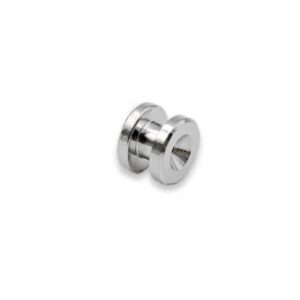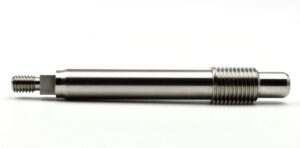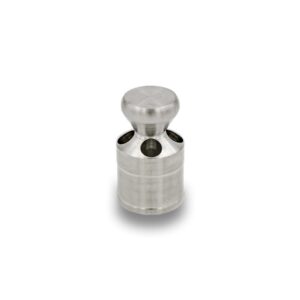Part 2: Finishing Services that Remove or Reshape the Component Surface
There are several surface finishing techniques that “remove or reshape the surface layer” of a precision machined component. These finishing techniques can be applied to a wide variety of materials, to both CNC Swiss and CNC turned components, and provide increased durability, tighter tolerances, better aesthetics and improved functionality for many applications.
Here is a list of some of the most common types of finishing services that “remove of reshape the surface layer” of turned component:
Electropolish –
is a polishing process that uses an electrical current to remove material from the surface of a machine component. This process improves the surface finish by leveling out the micro-peaks and valleys on the surface layer of metal created during the machining process. It is the opposite of electroplating, in which a current is used to add material to the surface of a machined component to level out the surface layer.
Grinding –
is a process that uses an abrasive grinding wheel to remove material from the surface of the precision turned component. This improves the surface finish and provides extremely accurate dimensions for a wide variety of applications. Depending on the geometry of the turned component, centerless or centered grinding may be used to complete the finishing process. Grinding can be done on the OD (outside diameter), ID (inside diameter) and a variety of types of features on the components (ie: holes, slots and flats).
- Honing – is a subset of grinding, used on the ID of a precision machined component. It is more like a polishing process than a true grinding process. The honing process uses a rotating stone (hone) with a fine abrasive to remove/polish a fine layer of the surface material.
- Lapping – is also a subset of grinding, used on the OD of a precision turned component to improve the surface finish and provide tighter dimensional controls. In this process, the abrasive material is in a paste form applied to a lap plate, and the component is passed against the plate to remove/polish the surface layer.
Laser engraving –
is a process that uses a laser to create an image (usually letters, numbers or a logo) on the surface a precision machined component. The laser beam vaporizes the metal. This process is used when the font or shape required can not be created during the turning (or milling) process.
Pickling –
is a chemical treatment that removes material from the surface layer of the metal. For precision machined components, it is most often used to clean (remove) the surface scale created during the heat treatment process. Components are dipped in an acid bath that dissolves the oxide scale from the surface level of the part.
Tumbling –
Barrel tumbling is a process that uses various sizes and types of tumbling media in a rotating barrel to rub against the surface layer of the components. This removes excess material, burrs, can harden the surface, polish out machining marks, brighten and burnish the parts. The size and type of media used will vary depending on the material of the component, its geometry (size and features) and final requirements. Tumbling media can be made of metals, ceramics and plastics and come in a wide variety of sizes and shapes.
Vibratory Finishing –
Similar to tumbling, turned components are put into a tub like machine that has vibratory media in it. The tub is vibrated so the media jostles against the part to remove surface marks, burrs and result in an improved finish. Vibratory finishing is used more often than barrel tumbling for turned components due to the complexity of features and tight tolerances of the parts.
Summary:
In Part 2 of this article series, finishing services the “remove or reshape the surface layer of a precision turned component” have been outlined for reference. In Part 1 of the series, finishing services that “add to or alter the surface layer” were provided as a reference guide.
Oil & Gas Industry Parts China has been producing precision turned pins, shafts, fasteners, poppets, rods, bolts, washers, screws, clips, ferrules, stems, o-rings, nuts, knobs, studs, buttons, and a wide range of other complex and tight tolerance components for their list of global manufacturing clients for over 30 years. Many of these components go into medical, aerospace, automotive, and industrial applications with unique finishing requirements.
Pioneer utilizes an extensive network of highly qualified partners for many of the finishing services required. This ensures that all orders are completed on-time and on-budget and with the highest level of quality. Whether the application calls for a component used in ventilator for the medical industry or on a piece of equipment used by the US military, the engineering and production team at Oil & Gas Industry Parts China can provide finished components to meet an extensive array of requirements.
To learn more about our AS9100 and ISO9001:2015 capabilities for turning precision components, contact Oil & Gas Industry Parts China today.



